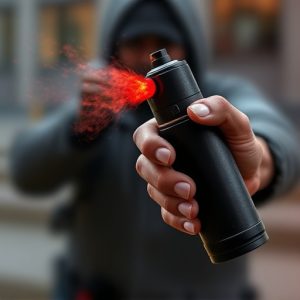How to Treat and Prevent Pepper Spray Exposure: Immediate & Long-term Care
TL;DR: To treat pepper spray exposure, immediately move to fresh air, flush affected areas with wate…….
TL;DR: To treat pepper spray exposure, immediately move to fresh air, flush affected areas with water for 15+ minutes, remove contaminated clothing, and rinse eyes gently. For skin contact, wash with soap and warm water for 10+ minutes, apply a cold compress, and seek medical attention promptly in severe cases or when symptoms worsen. Regular eye check-ups, monitor skin infections, and consider self-defence training to prevent future exposure.
“Personal security is a vital aspect of modern life, and understanding how to handle pepper spray exposure is an essential skill. This comprehensive guide delves into the world of inflammatory defense products, focusing on pepper spray. We explore the causes and symptoms of exposure, providing immediate treatment steps for swift relief. Additionally, discover long-term care strategies and prevention tactics to safeguard yourself in diverse scenarios. Learn how to navigate these situations effectively with our expert tips on How to Treat Pepper Spray Exposure.”
- Understanding Pepper Spray Exposure: Causes and Symptoms
- Immediate Steps to Treat and Alleviate Pepper Spray Exposure
- Long-term Care and Prevention Strategies for Pepper Spray Exposure
Understanding Pepper Spray Exposure: Causes and Symptoms
Pepper spray exposure occurs when an individual inhales or comes into direct contact with the irritant chemicals present in pepper spray. This defense product, often carried by law enforcement and security personnel, can cause a range of uncomfortable and potentially harmful effects. Understanding these causes and symptoms is crucial for knowing how to treat pepper spray exposure effectively.
Inhaling pepper spray can lead to coughing, difficulty breathing, and a burning sensation in the eyes and throat. Direct contact with skin may result in red, painful rashes or blisters. The severity of symptoms varies based on the amount of spray exposed and the duration of contact. To treat exposure, it’s essential to immediately move to an area with fresh air and flush any affected areas with water for at least 15 minutes. Medical attention should be sought if symptoms persist or worsen, ensuring proper care and comfort for the affected individual.
Immediate Steps to Treat and Alleviate Pepper Spray Exposure
If you’ve been exposed to pepper spray, it’s crucial to take immediate action to treat and alleviate the effects. The first step is to remove any contaminated clothing or shoes, being careful not to rub the affected area, as this can spread the irritants further. Rinse the eyes thoroughly with clean water for at least 15 minutes, ensuring that both the front and back of each eye are washed gently but thoroughly. If breathing becomes difficult, move to a well-ventilated area or use a face mask to aid respiration.
For skin contact, wash the affected areas with soap and warm water for at least 10 minutes. Consider using a mild detergent to help remove any residual spray. If irritation persists, apply a cold compress to soothe the skin. In cases of severe exposure or if symptoms worsen, seek medical attention promptly. Remember, how to treat pepper spray exposure involves quick thinking and taking appropriate steps to minimize discomfort and potential long-term effects.
Long-term Care and Prevention Strategies for Pepper Spray Exposure
Pepper spray exposure can have significant short-term and long-term effects, making it crucial to understand effective treatment and prevention strategies. In terms of how to treat pepper spray exposure, immediate action is key. Remove any contaminated clothing and wash the affected area with plenty of water for at least 15 minutes. This helps dilute the irritants and prevent further absorption. If breathing is difficult, move to a well-ventilated area or use a face mask to aid in respiration.
For long-term care, regular eye check-ups are essential as pepper spray can cause lasting damage to vision. Additionally, monitoring and treating any skin infections or irritations that may develop post-exposure. Preventive measures include attending self-defence courses to learn proper usage of pepper spray and maintaining it in a secure location to avoid accidental discharge. Regularly updating the spray’s expiration date and ensuring its effectiveness through quality testing are also vital components of long-term care strategies for pepper spray exposure.
Knowing how to treat pepper spray exposure is crucial for ensuring personal security. By understanding the causes and symptoms, taking immediate steps for treatment, and implementing long-term care strategies, you can effectively manage and prevent the adverse effects of exposure. Remember that prompt action is key, and these measures will help you navigate through challenging situations, providing relief and peace of mind.


